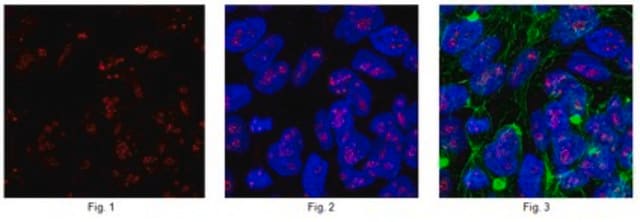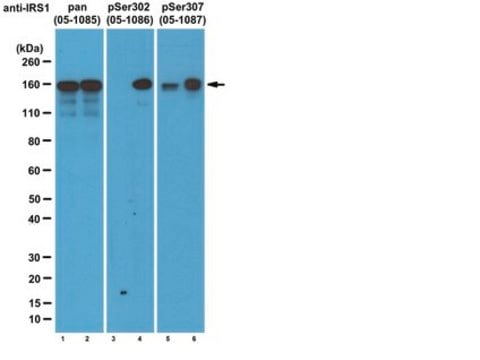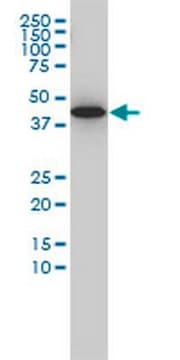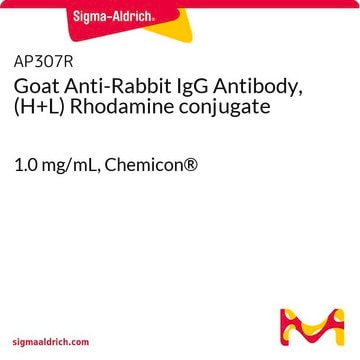ABN1727
Anti-CASZ1 Antibody
from guinea pig
Synonym(s):
Zinc finger protein castor homolog 1, Castor-related protein, CASZ1V1, CASZ1V2, Putative survival-related protein, Zinc finger protein 693
About This Item
Recommended Products
biological source
guinea pig
Quality Level
antibody form
unpurified
antibody product type
primary antibodies
clone
polyclonal
species reactivity
mouse, human
technique(s)
immunocytochemistry: suitable
immunofluorescence: suitable
immunoprecipitation (IP): suitable
western blot: suitable
NCBI accession no.
UniProt accession no.
shipped in
ambient
target post-translational modification
unmodified
Gene Information
human ... CASZ1(54897)
mouse ... Casz1(69743)
General description
Specificity
Immunogen
Application
Immunofluorescence Analysis: A 1:1,000 dilution from a representative lot detected CASZ1 immunoreactivity only among EYFP-negative cells, but not EYFP-positive Casz1-knockout cells by fluorescent immunohistochemistry staining of 4% paraformaldehyde-fixed retina cryosections from E17.5 transgenic mouse embryos carrying floxed Casz1 alleles and a ROSA26-floxed-stop::EYFP reporter allele, as well as Pax6 promoter-driven cre recombinase expression to allow tissue-specific (conditional) Casz1 knockout (Courtesy of Pierre Mattar, Christine Jolicoeur, and Michel Cayouette, Institut de recherches cliniques de Montreal (IRCM), Canada).
Immunoprecipitation Analysis: 5 µL from a representative lot immunoprecipitatd CASZ1 from 1 mg of mouse retina extract (Courtesy of Pierre Mattar, Christine Jolicoeur, and Michel Cayouette, Institut de recherches cliniques de Montreal (IRCM), Canada).
Western Blotting Analysis: A 1:1,000 dilution from a representative lot detected both CASZ1 spliced variants (CASZ1V1 and CASZ1V2) of either human or mouse origin in 20 µg of lysates from respective HEK293T transfectants (Courtesy of Pierre Mattar, Christine Jolicoeur, and Michel Cayouette, Institut de recherches cliniques de Montreal (IRCM), Canada).
Western Blotting Analysis: A 1:500 dilution from a representative lot detected a CASZ1 immunoreactive band in E17.5 mouse embryonic retina extract, but not in lysate from untransfected HEK293 cells (Courtesy of Pierre Mattar, Christine Jolicoeur, and Michel Cayouette, Institut de recherches cliniques de Montreal (IRCM), Canada).
Neuroscience
Quality
Western Blotting Analysis: A 1:5,000 dilution of this antiserum detected both CASZ1 spliced variants (CASZ1V1 and CASZ1V2) of either human or mouse origin in 10 µg of lysates from respective HEK293T transfectants.
Target description
Physical form
Storage and Stability
Handling Recommendations: Upon receipt and prior to removing the cap, centrifuge the vial and gently mix the solution. Aliquot into microcentrifuge tubes and store at -20°C. Avoid repeated freeze/thaw cycles, which may damage IgG and affect product performance.
Other Notes
Disclaimer
Not finding the right product?
Try our Product Selector Tool.
Storage Class Code
12 - Non Combustible Liquids
WGK
WGK 1
Flash Point(F)
Not applicable
Flash Point(C)
Not applicable
Certificates of Analysis (COA)
Search for Certificates of Analysis (COA) by entering the products Lot/Batch Number. Lot and Batch Numbers can be found on a product’s label following the words ‘Lot’ or ‘Batch’.
Already Own This Product?
Find documentation for the products that you have recently purchased in the Document Library.
Our team of scientists has experience in all areas of research including Life Science, Material Science, Chemical Synthesis, Chromatography, Analytical and many others.
Contact Technical Service








